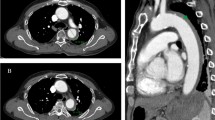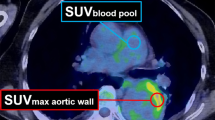Abstract
Background
The clinical course and predictors of adverse aortic events (AAE) in patients with acute Stanford type B intramural hematoma (IMH) remain controversial. This study aimed to investigate whether 18F-FDG PET/CT can predict risk in patients with acute type B IMH.
Methods and Results
This study included 34 patients with acute type B IMH who underwent PET/CT within 14 days from the onset of symptoms. The maximal standardized uptake values (SUVmax) of 18F-FDG uptake was significantly different between patients with or without AAE (4.3 ± 0.6 vs 3.7 ± 1.0, P = 0.020), but not the target to blood ratio (TBR, SUVmax divided by SUV in the superior vena cava) (1.6 ± 0.2 vs 1.5 ± 0.5, P = 0.064). In patients with initial ulcer-like projection (ULP), a blood-filled pouch protruding into the IMH, which was seen in 25 patients(74%), both the SUVmax and TBR were significantly higher in patients who developed AAE, (4.3 ± 0.6 vs 3.3 ± 0.5, P = 0.001; 1.6 ± 0.2 vs 1.4 ± 0.2, P = 0.01); the TBR >1.5, which is determined from receiver-operating-characteristic curve, had a sensitivity of 73% and a specificity of 80% in predicting AAE.
Conclusion
Patients with ULP and high 18F-FDG uptake were more likely to develop AAE and may require closer surveillance with serial imaging.




Similar content being viewed by others
Abbreviations
- AAS:
-
Acute aortic syndrome
- CTA:
-
Computed tomography angiography
- 18F-FDG:
-
18F-fluorodeoxyglucose
- IMH:
-
Intramural hematoma
- PAU:
-
Penetrating aortic ulcer
- PET/CT:
-
Positron emission tomography/computed tomography
- SUV:
-
Standardized uptake value
- TBR:
-
Target to blood ratio
- TEVAR:
-
Thoracic endovascular repair
- ULP:
-
Ulcer-like projection
References
Erbel R, Aboyans V, Boileau C, Bossone E, Bartolomeo RD, Eggebrecht H, et al. 2014 ESC Guidelines on the diagnosis and treatment of aortic diseases: Document covering acute and chronic aortic diseases of the thoracic and abdominal aorta of the adult. The task force for the diagnosis and treatment of aortic diseases of the european society of cardiology (ESC). Eur Heart J. 2014;35:2873-926.
Nienaber CA, von Kodolitsch Y, Petersen B, Loose R, Helmchen U, Haverich A, et al. Intramural hemorrhage of the thoracic aorta. Diagnostic and therapeutic implications. Circulation. 1995;92:1465-72.
Song JK, Kim HS, Kang DH, Lim TH, Song MG, Park SW, et al. Different clinical features of aortic intramural hematoma versus dissection involving the ascending aorta. J Am Coll Cardiol. 2001;37:1604-10.
Kaji S, Akasaka T, Katayama M, Yamamuro A, Yamabe K, Tamita K, et al. Long-term prognosis of patients with type B aortic intramural hematoma. Circulation. 2003;108:II307-11.
Evangelista A, Mukherjee D, Mehta RH, O’Gara PT, Fattori R, Cooper JV, et al. Acute intramural hematoma of the aorta: A mystery in evolution. Circulation. 2005;111:1063-70.
Mussa FF, Horton JD, Moridzadeh R, Nicholson J, Trimarchi S, Eagle KA. Acute aortic dissection and intramural hematoma. JAMA. 2016;316:754.
von Kodolitsch Y, Csosz SK, Koschyk DH, Schalwat I, Loose R, Karck M, et al. Intramural hematoma of the aorta: Predictors of progression to dissection and rupture. Circulation. 2003;107:1158-63.
Evangelista A, Dominguez R, Sebastia C, Salas A, Permanyer-Miralda G, Avegliano G, et al. Prognostic value of clinical and morphologic findings in short-term evolution of aortic intramural haematoma. Therapeutic implications.Eur Heart J. 2004;25:81-7.
Kitai T, Kaji S, Kim K, Ehara N, Tani T, Kinoshita M, et al. Prognostic value of sustained elevated C-reactive protein levels in patients with acute aortic intramural hematoma. J Thorac Cardiovasc Surg. 2014;147:326-31.
Shimizu H, Yoshino H, Udagawa H, Watanuki A, Yano K, Ide H, et al. Prognosis of aortic intramural hemorrhage compared with classic aortic dissection. Am J Cardiol. 2000;85:792-5.
Song JK, Kim HS, Song JM, Kang DH, Ha JW, Rim SJ, et al. Outcomes of medically treated patients with aortic intramural hematoma. Am J Med. 2002;113:181-7.
Moizumi Y, Komatsu T, Motoyoshi N, Tabayashi K. Clinical features and long-term outcome of type A and type B intramural hematoma of the aorta. J Thorac Cardiovasc Surg. 2004;127:421-7.
Quint LE, Williams DM, Francis IR, Monaghan HM, Sonnad SS, Patel S, et al. Ulcerlike lesions of the aorta: Imaging features and natural history. Radiology. 2001;218:719-23.
Jang YM, Seo JB, Lee YK, Chae EJ, Park SH, Kang JW, et al. Newly developed ulcer-like projection (ULP) in aortic intramural haematoma on follow-up CT: Is it different from the ULP seen on the initial CT? Clin Radiol. 2008;63:201-6.
Kitai T, Kaji S, Yamamuro A, Tani T, Kinoshita M, Ehara N, et al. Impact of new development of ulcer-like projection on clinical outcomes in patients with type B aortic dissection with closed and thrombosed false lumen. Circulation. 2010;122:S74-80.
Eggebrecht H, Plicht B, Kahlert P, Erbel R. Intramural hematoma and penetrating ulcers: Indications to endovascular treatment. Eur J Vasc Endovasc Surg. 2009;38:659-65.
Sueyoshi E, Nagayama H, Hashizume K, Eishi K, Sakamoto I, Uetani M. Computed tomography evaluation of aortic remodeling after endovascular treatment for complicated ulcer-like projection in patients with type B aortic intramural hematoma. J Vasc Surg. 2014;59:693-9.
Grimm M, Loewe C, Gottardi R, Funovics M, Zimpfer D, Rodler S, et al. Novel insights into the mechanisms and treatment of intramural hematoma affecting the entire thoracic aorta. Ann Thorac Surg. 2008;86:453-6.
Morris JH, Mix D, Cameron SJ. Acute aortic syndromes: Update in current medical management. Curr Treat Options Cardiovas Med. 2017;19:29.
Blockmans D, de Ceuninck L, Vanderschueren S, Knockaert D, Mortelmans L, Bobbaers H. Repetitive 18F-fluorodeoxyglucose positron emission tomography in giant cell arteritis: A prospective study of 35 patients. Arthritis Rheum. 2006;55:131-7.
Walter MA, Melzer RA, Schindler C, Muller-Brand J, Tyndall A, Nitzsche EU. The value of [18F]FDG-PET in the diagnosis of large-vessel vasculitis and the assessment of activity and extent of disease. Eur J Nucl Med Mol Imaging. 2005;32:674-81.
Tokuda Y, Oshima H, Araki Y, Narita Y, Mutsuga M, Kato K, et al. Detection of thoracic aortic prosthetic graft infection with 18F-fluorodeoxyglucose positron emission tomography/computed tomography. Eur J Cardiothorac Surg. 2013;43:1183-7.
Soussan M, Nicolas P, Schramm C, Katsahian S, Pop G, Fain O, et al. Management of large-vessel vasculitis with FDG-PET. Medicine. 2015;94:e622.
Evangelista A, Dominguez R, Sebastia C, Salas A, Permanyer-Miralda G, Avegliano G, et al. Long-term follow-up of aortic intramural hematoma: Predictors of outcome. Circulation. 2003;108:583-9.
Nienaber CA, Sievers HH. Intramural hematoma in acute aortic syndrome: More than one variant of dissection? Circulation. 2002;106:284-5.
Winnerkvist A, Lockowandt U, Rasmussen E, Radegran K. A prospective study of medically treated acute type B aortic dissection. Eur J Vasc Endovasc Surg. 2006;32:349-55.
Nienaber CA, Kische S, Rousseau H, Eggebrecht H, Rehders TC, Kundt G, et al. Endovascular repair of type B aortic dissection: Long-term results of the randomized investigation of stent grafts in aortic dissection trial. Circ Cardiovasc Interv. 2013;6:407-16.
Sueyoshi E, Imada T, Sakamoto I, Matsuoka Y, Hayashi K. Analysis of predictive factors for progression of type B aortic intramural hematoma with computed tomography. J Vasc Surg. 2002;35:1179-83.
Kitai T, Kaji S, Yamamuro A, Tani T, Kinoshita M, Ehara N, et al. Detection of intimal defect by 64-row multidetector computed tomography in patients with acute aortic intramural hematoma. Circulation. 2011;124:S174-8.
Gorla R, Erbel R, Kuehl H, Kahlert P, Tsagakis K, Jakob H, et al. Prognostic value of 18F-fluorodeoxyglucose PET-CT imaging in acute aortic syndromes: Comparison with serological biomarkers of inflammation. Int J Cardiovasc Imaging. 2015;31:1677-85.
Kato K, Nishio A, Kato N, Usami H, Fujimaki T, Murohara T. Uptake of 18F-FDG in acute aortic dissection: A determinant of unfavorable outcome. J Nucl Med. 2010;51:674-81.
Kuehl H, Eggebrecht H, Boes T, Antoch G, Rosenbaum S, Ladd S, et al. Detection of inflammation in patients with acute aortic syndrome: Comparison of FDG-PET/CT imaging and serological markers of inflammation. Heart. 2008;94:1472-7.
Reeps C, Essler M, Pelisek J, Seidl S, Eckstein H, Krause B. Increased 18F-fluorodeoxyglucose uptake in abdominal aortic aneurysms in positron emission/computed tomography is associated with inflammation, aortic wall instability, and acute symptoms. J Vasc Surg. 2008;48:417-23.
Reeps C, Pelisek J, Bundschuh RA, Gurdan M, Zimmermann A, Ockert S, et al. Imaging of acute and chronic aortic dissection by 18F-FDG PET/CT. J Nucl Med. 2010;51:686-91.
Disclosure
No grants, contracts, or any other forms of financial support were involved in this study. There was no relationship between this study and any industry.
Author information
Authors and Affiliations
Corresponding author
Additional information
The authors of this article have provided a PowerPoint file, available for download at SpringerLink, which summarises the contents of the paper and is free for re-use at meetings and presentations. Search for the article DOI on SpringerLink.com.
Electronic Supplementary Material
Below is the link to the electronic supplementary material.
Rights and permissions
About this article
Cite this article
Yang, F., Luo, J., Hou, Q. et al. Predictive value of 18F-FDG PET/CT in patients with acute type B aortic intramural hematoma. J. Nucl. Cardiol. 26, 633–641 (2019). https://doi.org/10.1007/s12350-017-1014-9
Received:
Revised:
Published:
Issue Date:
DOI: https://doi.org/10.1007/s12350-017-1014-9




